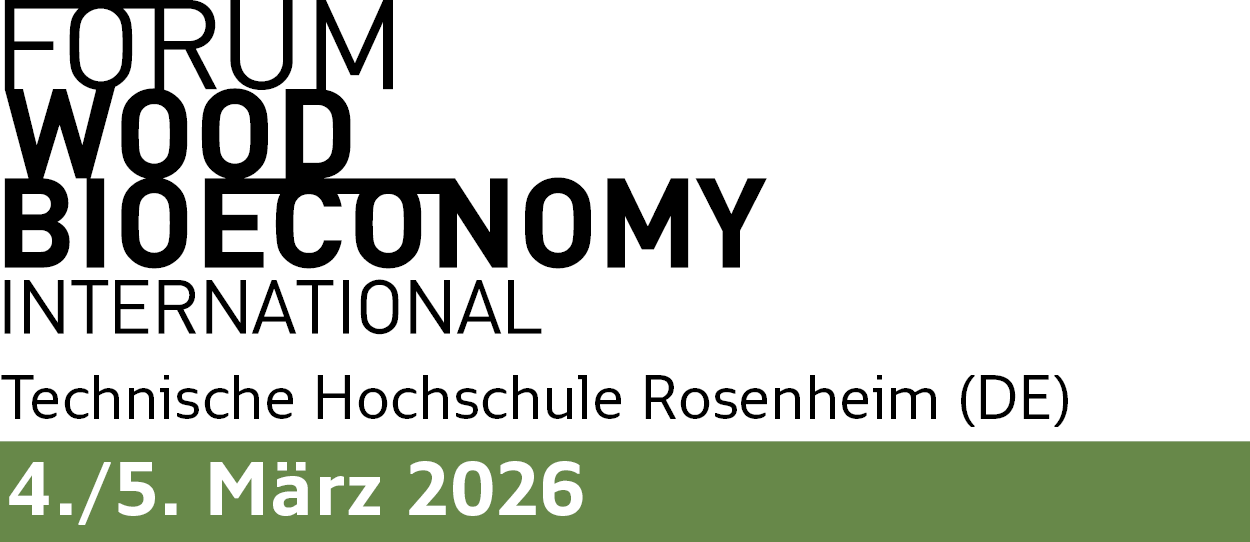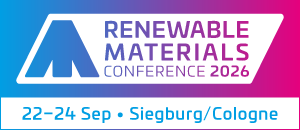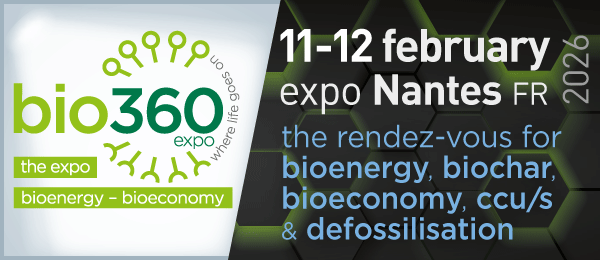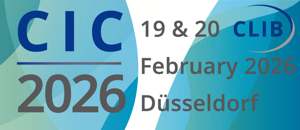In 2022, the United Kingdom generated about 1.45 million tonnes of used textiles. The environmental impact of textile consumption in the UK is significant, with carbon and water footprints reaching 32.9 million tonnes of CO2e and 4.98 billion cubic meters of water, respectively. Let’s bear in mind that almost 60% of fibres produced annually worldwide still originate from fossil fuels.
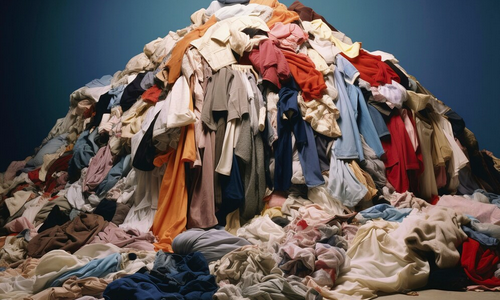
Textile waste can be categorised into pre-consumer and post-consumer waste. Pre-consumer waste includes textiles generated during manufacturing, operations, and distribution processes, as well as unsold clothing. Post-consumer waste comprises used textiles discarded by consumers. The majority of textile waste generated globally falls into the post-consumer category.
Recycling textiles is often regarded as a crucial solution to the issue of textile waste. Recent estimates indicate that Europe’s potential future fibre-to-fibre recycling capacity could technically recycle up to 70% of all textile waste by 2030.3 This change could reduce the carbon footprint by up to 90% for certain fibre types compared to virgin fibres, and also decrease land, water, and chemical usage. However, according to the Ellen MacArthur Foundation currently less than 1% of textiles produced for clothing are recycled into new clothes.4
Additionally, only around 10% of textile waste undergoes open-loop recycling, where textiles are repurposed into new products that differ from their original form.3 This process often involves converting used fabrics into materials for other industries or creating lower-quality and less functional products within the fashion industry. The fibres with the greatest potential for fibre-to-fibre (i.e., closed-loop) recovery are typically polyester and cotton.
Textile recycling routes
Textile recycling routes are usually categorised as either mechanical, chemical or, less frequently, thermal and biochemical. Mechanical recycling is the most established process for textile recycling. It involves breaking down garments by chopping them into shredded fragments and then using a pulling process to produce shoddy. This method utilises both pre-consumer and post-consumer waste streams, although the latter is more challenging due to various fabric blends and colours. Before textiles can enter the recycling process, all hardware such as buttons and zippers must be removed.
One of the limitations of mechanical recycling is that the fibres are shortened during the shredding process. Consequently, the production of new yarn often requires blending the recycled fibre with virgin fibres to achieve the necessary strength and quality for apparel. Overall, mechanical processes are scalable and associated costs are lower than those of chemical or biochemical processes. However, they produce materials with reduced quality, limiting opportunities for high-value textile applications. Moreover, mechanical reprocessing through multiple closed-loop cycles is unlikely to be viable due to the serial degradation of fibre lengths in each cycle.
Chemical recycling refers to technologies that break down textile waste into its basic chemical building blocks. This process involves depolymerising fibre polymers (in the case of synthetic fibres) or dissolving them (in the case of cellulosic fibres). Once the material is reduced to its molecular level, it is then repolymerised and respun into new fibres. Typically, textile waste undergoes a mechanical pretreatment step before entering the chemical recycling process.
Chemical recycling is theoretically better positioned to facilitate a fully circular system as it can produce recycled fibres of full length after the repolymerisation of the depolymerised material, thus retaining both quality and value of the virgin material. Additionally, chemical recycling can separate some fibre blends, which mechanical recycling typically cannot achieve. When fibres are homogenously mixed within a fabric, mechanical separation becomes very challenging; however, chemical methods can accomplish this by exploiting the different properties of the fibres.
The Hong Kong Research Institute of Textiles and Apparel (HKRITA) has been at the forefront of this recycling technology. They developed a solution to separate polyester fibre from polycotton blends using a green solvent-based technology known as The Green Machine.5 This process results in polyester fibre with no quality loss and cellulose powder after drying the cellulose.
Another example of this technology is implemented by the UK-based company Worn Again Technologies. They currently operate a demonstration-scale plant in Winterthur, Switzerland, designed to handle hard-to-recycle fabric blends such as polyester and cotton mixes. Worn Again Technologies aims to have 40 licensed plants by 2040, each with a capacity of 50,000 tonnes per year.6 This would result in two million tonnes of polyester and cellulosic raw materials being reintegrated into supply chains for making new textiles like viscose and recycled polyester.
It is also worth mentioning that enzymatic processes are being explored for fibre-to-fibre recycling, although they are still in their infancy. Enzymatic recycling offers recognised benefits, such as relatively mild conditions, making it less energy-intensive and more environmentally friendly than chemical recycling processes, while generating virgin-quality recycled material. However, enzymatic recycling currently faces challenges in scaling up. Further research is needed, yet earlier this year, Australian environmental technology startup Samsara Eco, in collaboration with athletic apparel company Lululemon, unveiled the world’s first enzymatically recycled nylon 6,6 product and has since received significant investment.
Textile waste in the UK
In 2022, the UK consumed 1.42 million tonnes of virgin textiles and generated approximately 1.40 million tonnes of post-consumer textiles. Of this, 650,000 tonnes were diverted to reuse and recycling. Additionally, 276,000 tonnes of post-consumer textiles were sold to the public, whilst 421,600 tonnes were exported (Figure 1).1
WRAP has highlighted a significant concern: over half of post-consumer textiles generated in the UK were discarded into residual waste streams such as black bins and general waste at Household Waste Recycling Centres (HWRCs) in 2022. Of this material, 84% is incinerated with energy recovery, and 11% is sent to landfill, raising significant concerns for the industry’s circular economy goals.1
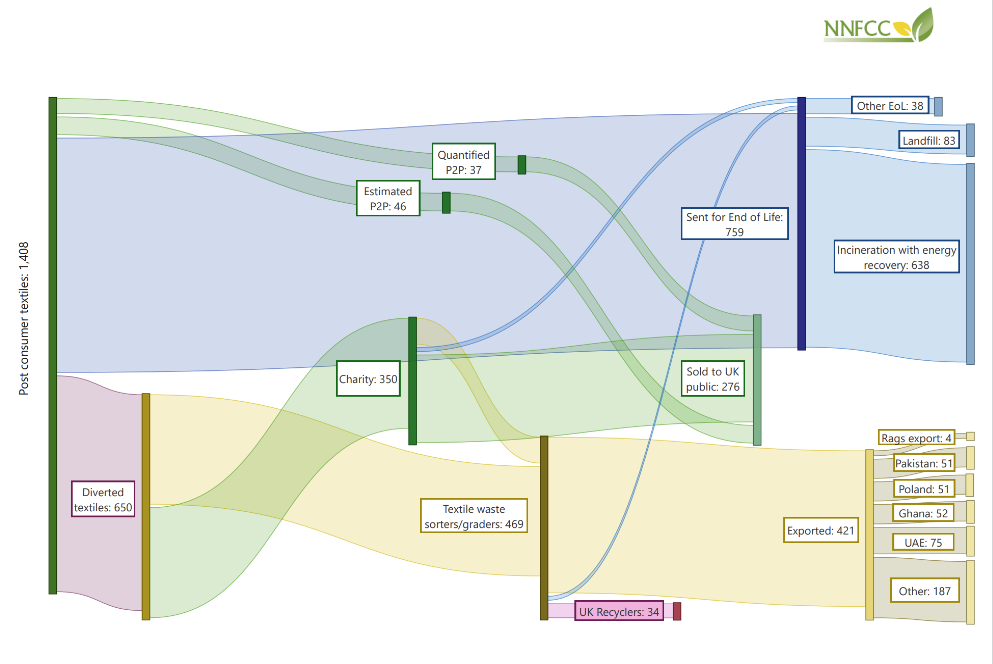
(adapted from WRAP).1
End uses for post-consumer textiles in the UK
Two primary end markets exist for collected post-consumer textiles: export and recycling. In 2022, 421,600 tonnes of diverted post-consumer textiles were exported from the UK.1 This accounts for 60% of the estimated post-consumer textiles collected and 30% of the post-consumer textiles generated annually. The UK is a significant exporter of used clothing, ranking among the top countries in the world. Whilst some of the exported textiles are processed by waste management services, others are incinerated near their destination markets, releasing pollution from synthetic fabrics into the air. The remaining textiles are discarded in unregulated landfills or scattered across the beaches of Ghana and the dunes of the Atacama Desert in Chile. However, countries in Africa and Asia that once accepted used clothing from the West are increasingly rejecting these imports.7 Meanwhile, Denmark, France and Sweden have recently called for new global rules under the Basel Convention to regulate the export of textile waste to developing countries.8
The other market for post-consumer textiles is UK based recycling, with feedstock volume estimated at around 34,000 tonnes in 2022.1 This material is primarily sourced directly from used textile collectors, sorters, graders, or charities. This waste is mechanically recycled, mainly in open-loop processes, generating products such as non-wovens and insulation materials. In the UK, mechanical fibre-to-fibre recycling is currently limited to wool and cotton, with the recent launch of the UK’s first commercial post-consumer polyester recycling plant earlier this year. Project Re:Claim, a joint venture between the Salvation Army and recycling specialist Project Plan B, aims to recycle 2,500 tonnes of polyester waste this year, with plans to double that amount by 2025. The plant produces polyester pellets that can be spun into yarn for use in textiles and other industrial applications.9
Chemical recycling ventures in the UK remain in trial or pilot phases. Challenges in fibre-to-fibre recycling extend beyond capacity and infrastructure limitations to include collection, sorting, and pre-processing capabilities. The Textile Recycling Association (TRA) has recently urged the UK Government to implement its long-overdue Extended Producer Responsibility (EPR). scheme, akin to the EU’s, given the nearing full capacity of processing plants operated by textile collectors and sorters nationwide.10 The EPR would require producers to cover the costs associated with the end-of-life management of their products, encouraging them to reduce waste and increase the circularity of textile products.
Concurrently, the UK Fashion and Textile association (UKFT) leads a pioneering initiative for the development of the UK’s first Automated Textile Sorting and Pre-processing facility (ATSP).11 This project aims to enable efficient, high-volume feedstock supply to existing and emerging fibre-to-fibre recycling facilities.
In the circular economy, effective waste collection is crucial for efficient recycling. A harmonised process for waste management collection and separation is essential. With the EU’s upcoming regulations mandating separate textile waste collection by 2025, the implementation of the EPR, and restrictions on exports/imports of second-hand clothing, textile collection rates are expected to increase. However, it is evident that sorting and recycling capacities for clothes and household textiles will need to be scaled up simultaneously across Europe.
Conclusions
Textile waste is a pressing global issue, with over 90 million tonnes generated annually, most of which ends up in overcrowded landfills. Instead of being discarded, textile waste should be viewed as a valuable resource that can revolutionise the highly polluting fashion industry. To harness the potential of textile waste, effective harmonised waste management practices, such as Extended Producer Responsibility (EPR), are essential. However, it is crucial to remember the importance of the first step in the waste hierarchy: minimising waste creation by reducing the production and consumption of virgin textile products. The European Commission has set a goal for all textile products placed on the EU market to be durable, repairable, and recyclable, aiming to “make fast fashion out of fashion” by 2030. This means that both overproduction and overconsumption must be curbed. Instead, reuse and recycling of textiles should be promoted, extending the practical service life of textile products.
References
1 WRAP, 2024. Textiles Market Situation Report 2024. [online] Available at:
https://www.wrap.ngo/sites/default/files/2024-
03/Textiles%20Market%20Situation%20Report%202024.pdf [Accessed July 2024].
2 Textile Exchange, 2023. Materials market report 2023. [online] Available at:
https://textileexchange.org/app/uploads/2023/11/Materials-Market-Report-2023.pdf [Accessed July
2024].
3 McKinsey & Company, 2022. Scaling textile recycling in Europe – turning waste into value. [online]
Available at: https://www.mckinsey.com/industries/retail/our-insights/scaling-textile-recycling-in-
europe-turning-waste-into-value [Accessed July 2024].
4 Ellen MacArthur Foundation, 2017. A new textiles economy: Redesigning fashion’s future. [online]
Available at: https://archive.ellenmacarthurfoundation.org/assets/downloads/A-New-Textiles-
Economy.pdf [Accessed July 2024].
5 HKRITA | Green Machine: Post-consumer Blended Textile Separation and Recycling by Hydrothermal
Treatment Phase 2. [online] Available at: https://www.hkrita.com/en/our-innovation-
tech/projects/green-machine-phase-2 [Accessed July 2024].
6 The Conduit, 2021. Worn Again Technologies: the technology transforming the textiles industry.
[online] Available at: https://www.theconduit.com/insights/climate-change-sustainability/worn-again-
technologies-the-technology-transforming-the-textiles-industry/ [Accessed July 2024].
7 Sylvana Lijbaart, 2023. Uganda bans the import of discarded clothing from Europe and the US.
Available at: https://fashionunited.uk/news/business/uganda-bans-the-import-of-discarded-clothing-
from-europe-and-the-us/2023082871267 [Accessed July 2024].
8 Heunicke M., Pourmokhtari, R., Béchu, C., 2024. Denmark, Sweden and France call for new global rules on exporting textile waste to developing countries. [online] Available at:
https://mim.dk/media/aw2n3dts/joint-statement.pdf [Accessed July 2024].
9 The Salvation Army, 2024. New polyester recycling plant opens in UK to tackle textile waste. [online]
Available at: https://salvationarmytrading.org.uk/news/new-polyester-recycling-plant-opens-in-uk-to-
tackle-textile-waste/ [Accessed July 2024].
10 Textile Recycling Association, 2024. Textile recycling sector faces unprecedented financial crisis amid
global market challenges. [online] Available at: https://www.textilerecyclingassociation.org/press/textile-recycling-sector-faces-unprecedented-financial-crisis-amid-global-market-challenges/ [Accessed July 2024].
11 UKFT | Automatic sorting for Circularity in Textiles (ACT UK). [online] Available at: https://ukft.org/innovation/act-uk/ [Accessed July 2024].
Source
NNFCC, press release, 2024-07-23.
Supplier
European Commission
Government of the United Kingdom
Hong Kong Research Institute of Textiles and Apparel (HKRITA)
lululemon athletica
Project Plan B
Salvation Army
Textile Recycling Association
UK Fashion and Textile association UKFT
Worn Again Technologies
Share
Renewable Carbon News – Daily Newsletter
Subscribe to our daily email newsletter – the world's leading newsletter on renewable materials and chemicals






